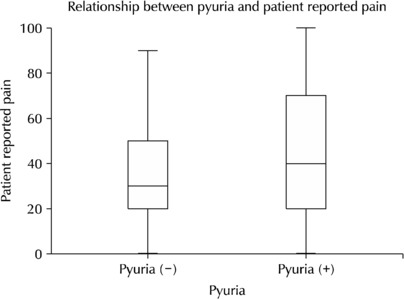Search
- Page Path
- HOME > Search
Review Article
- Postoperative Microscopic Pyuria and Role of Damage-Associated Molecular Pattern: A Literature Review
- Min-Kyu Kim, Ki Hong Kim
- Urogenit Tract Infect 2024;19(3):73-79. Published online December 31, 2024
- DOI: https://doi.org/10.14777/uti.2448026013
-
 Abstract
Abstract
 PDF
PDF PubReader
PubReader ePub
ePub - All patients who undergo transurethral prostate surgery exhibit pyuria and microscopic hematuria in postoperative urinalysis. Postoperative asymptomatic pyuria is associated with the inflammatory process and surface remodeling of the prostate, rather than infection. Various studies have investigated the incidence, duration, and risk factors for postoperative pyuria, noting that factors like age, surgery time, and prostate size can influence outcomes. Postoperative pyuria reflects tissue recovery and inflammation, and the use of antibiotics in asymptomatic patients may not be appropriate.
- 3,086 View
- 21 Download

Original Articles
- Does Music Have a Calming Effect on Pain and Anxiety in Patients Undergoing Cystoscopy?
- Ye Chan Joo, Ji Eun Yu, Jae Hyun Baik, Young Seop Chang, Jin Bum Kim, Hyung Joon Kim, Dong Hoon Koh, Hong Wook Kim
- Urogenit Tract Infect 2024;19(1):3-9. Published online April 30, 2024
- DOI: https://doi.org/10.14777/uti.2024.19.1.3

-
 Abstract
Abstract
 PDF
PDF Supplementary Material
Supplementary Material PubReader
PubReader ePub
ePub - Purpose: Cystoscopy is a diagnostic test performed frequently in urology outpatient clinics. Despite the large number of inspections, the associated pain, discomfort, or anxiety can markedly affect patient compliance and adherence to subsequent surveillance protocols. This study conducted a prospective, randomized study to investigate the potential efficacy of music and pyuria on pain or anxiety during outpatient cystoscopy.
Materials and Methods: In this single-institution, randomized study, the participants were assigned to a music-intervention or non-music control group. The music-intervention group underwent an identical procedure with the addition of Johann Sebastian Bach’s “Air on the G String” from Suite No. 3 in D major, BWV 1068. Urinalysis was performed to determine if pyuria affects pain during the procedure.
Results: The patient-reported outcomes, encompassing the changes in the STAI-X-1 (State-Trait Anxiety Inventory-X-1) scores, subjective levels of discomfort, embarrassment, satisfaction, and pain, were similar in the two groups. In contrast, the surgeons reported statistically significant differences in their evaluations of the same items as patient-reported outcomes of the two groups. The patient-reported pain showed no significant differences between the pyuria-negative group (0-2 and 3-5 WBC/HPF) and pyuria-positive group (>5 WBC/HPF).
Conclusions: The data from this study do not support the hypothesis that musical intervention during cystoscopy alleviates pain or anxiety to any significant extent. In addition, pyuria did not affect the patient’s reported pain. Nevertheless, a notable impact was observed in the surgeons’ assessments, suggesting that the musical accompaniment may alter the surgeons’ perception of patient pain and anxiety levels throughout the procedure.
- 1,827 View
- 32 Download

- Is Preoperative Pyuria Associated with Postoperative Febrile Complication after Ureteroscopic Ureter or Renal Stone Removal?
- Seungsoo Lee
- Urogenit Tract Infect 2020;15(1):1-5. Published online April 30, 2020
- DOI: https://doi.org/10.14777/uti.2020.15.1.1
-
 Abstract
Abstract
 PDF
PDF PubReader
PubReader ePub
ePub - Purpose: The association between preoperative pyuria and postoperative febrile complications after ureteroscopic ureter or renal stone removal was examined.
Materials and Methods: From June 2014 to July 2016, 110 patients who underwent ureteroscopic ureter or renal stone removal by a single surgeon were evaluated. The patients were categorized as the “pyuria group” and “nonpyuria group.” The sex, age, stone laterality, stone location, stone size, preoperative urine culture results, and postoperative complications in each group were analyzed.
Results: The pyuria and nonpyuria groups were comprised of 55 patients each. The mean ages the pyuria and nonpyuria groups were 58.4±16.1 years and 54.4±13.2 years, respectively. There were respectively, 43 and 12 unilateral and bilateral stones in the pyuria group, and 53 and two in the nonpyuria group. The stone sizes of the pyuria and nonpyuria groups were 13.1±5.4 mm and 11.1±4.7 mm, respectively. The pyuria group contained more patients with bilateral stones and larger stones than the nonpyuria group. Five and two postoperative febrile complications were encountered in the pyuria group and the nonpyuria group, respectively. No significant difference in febrile complications was observed between the two groups. In logistic regression analysis, bilateral stones and larger stones were associated with pyuria.
Conclusions: In ureteroscopic stone removal surgery, preoperative pyuria was associated with bilateral and larger stones, but there were no associations with febrile complications.
- 859 View
- 3 Download


 KAUTII
KAUTII
 First
First Prev
Prev


